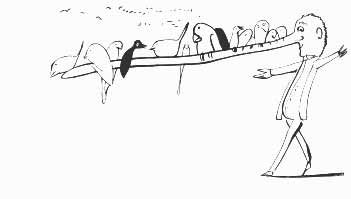|

Edward Lear
1812
- 1888
Edward Lear
was born in London, the twentieth child of a stockbroker. Although
the family was initially wealthy, his father went bankrupt when
he was three, and the family never regained its former wealth.
When his father retired, Edward was cared for by his sister Anne.
From the age of fourteen they shared rented rooms and she encouraged
his natural talent for drawing and painting, and despite
the fact that he had never received any formal artistic training,
his work became well known.From the age of sixteen he was commissioned
to produce illustrations of various kinds. Lears subjects
included birds and landscapes. His chief work was small water-colours,
thousands of which survive today.
Edward
Lear is mostly remembered not for his considerable talent as an
artist but for his Nonsense Rhymes. He is credited with
inventing the Limerick, which he wrote to amuse the children of
his wealthy clients. As well as the Limericks he wrote other nonsense
rhymes such as " The Owl and The Pussycat" and "
The Jumblies" .

Edward
Lear kept his epilepsy, so secret that hardly anyone knew about
it until after his death. He once said " It is wonderful
that these fits have never been discovered".
Lears
epilepsy began when he was about seven. His
seizures were 'petit-mal' and resulted in short black-outs,
or absences, His sister Harriet had taught him to control his
seizures with a combination of relaxation and will-power.
When he felt the aura which preceeded an attack, Lear would retire,
usually to another room, where he would lie down and try to stay
calm.
Lear
recollects his first seizure, when his father took him to a fair
near Highgate,
"there was a performance of gymnastic clowns...and
a band. The music was good- at least it attracted me:-
and the sunset and twilight I remember as if yesterday.
And I can recollect crying half the night after all the gaiety
had broke up-and also suffering for days at the memory of the
past scene"
A
the years went by his seizures became more severe, but less frequent.
He kept diaries in which he placed an 'X' next to the dates he
had seizures, and a score of between 1 to 10 to mark its severity.
He described himself as 'coming to awful grief"
at these times, but generally Lear wrote little on the subject
of his fears surrounding living with epilepsy.
Edward,
like many of his contemporaries who had epilepsy, was deeply
ashamed of his condition. His sister Ann was partly responsible
for this. "The Demon" as he always called
his attacks was replaced later on by the description "The
Morbids", Lear's word for a state of nostalgic despair.
Lear was also convinced, like many of his contemporaries that
epilepsy would lead to a deterioration of the brain and early
death. He had watched his elder sister Jane have numerous
seizures when he was a child, and she had died before reaching
adulthood, posibly falling victim to SUDEP(Sudden Unexplained
Death in Epilepsy).
For
much of his life, Lear travelled extensively in France, Italy,
Albania and Greece, recording the landscapes. He managed to make
a living off his paintings and drawings. He published
four books of Nonsense, two illustrated books of Natural History,
and six travel books.
|

